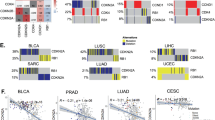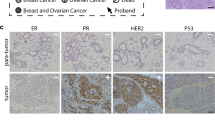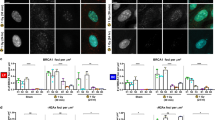Abstract
The protein RB1CC1 (retinoblastoma 1 (RB1)-inducible coiled-coil 1) has been identified as a key regulator of the tumor-suppressor gene RB1 (ref. 1). RB1CC1 is localized in the nucleus and has been proposed to be a transcription factor because of its nuclear localization signal, leucine zipper motif and coiled-coil structure1,2. The gene RB1CC1 is localized to a region of chromosome 8q11 (ref. 2) containing several loci of putative tumor-suppressor genes3,4; however, its role in human cancers remains to be determined. Here we report that 20% (7 of 35) of primary breast cancers examined contained mutations in RB1CC1, including nine large interstitial deletions predicted to yield markedly truncated RB1CC1 proteins. Wildtype RB1CC1 and RB1 were absent or significantly less abundant than normal in the seven cancers with mutations in RB1CC1, but were abundant in cancers without such mutations. In all seven cancers, both RB1CC1 alleles were inactivated; two showed compound heterozygous deletions. Thus, RB1CC1 is frequently mutated in breast cancer and shows characteristics of a classical tumor-suppressor gene.
This is a preview of subscription content, access via your institution
Access options
Subscribe to this journal
Receive 12 print issues and online access
$209.00 per year
only $17.42 per issue
Buy this article
- Purchase on Springer Link
- Instant access to full article PDF
Prices may be subject to local taxes which are calculated during checkout




Similar content being viewed by others
Accession codes
References
Chano, T. et al. Identification of RB1CC1, a novel gene that can induce RB1 in various human cells. Oncogene 21, 1295–1298 (2002).
Chano, T. et al. Isolation, characterization and mapping of the mouse and human RB1CC1 genes. Gene (in press).
Dahiya, R., Perinchery, G., Deng, G. & Lee, C. Multiple sites of loss of heterozygosity on chromosome 8 in human breast cancer has differential correlation with clinical parameters. Int. J. Oncol. 12, 811–816 (1998).
Perinchery, G. et al. Loss of two new loci on chromosome 8 (8p23 and 8q12-13) in human prostate cancer. Int. J. Oncol. 14, 495–500 (1999).
Kaelin, W.G. Jr. Functions of the retinoblastoma protein. BioEssays 21, 950–958 (1999).
Kamb, A. Cell cycle regulators and cancers. Trends Genet. 11, 136–140 (1995).
Taya, Y. RB kinases and RB-binding proteins: new points of view. Trends Biol. Sci. 22, 14–17 (1997).
T'Ang, A., Varley, J.M., Chakraborty, S., Murphree, A.L. & Fung, Y.K. Structural rearrangement of the human retinoblastoma gene in human breast carcinoma. Science 242, 263–266 (1988).
Bieche, I. & Lidereau, R. Loss of heterozygosity at 13q14 correlate with RB1 gene underexpression in human breast cancer. Mol. Carcinog. 29, 151–158 (2000).
Thorlacious, S., Jonasdottir, O. & Eyfjord, J.E. Loss of heterozygosity at selective sites on chromosomes 13 and 17 in human breast carcinoma. Anticancer Res. 11, 1501–1507 (1991).
Lemoine, N.R. Molecular biology of breast cancer. Ann. Oncol. 5 (Suppl. 4), 31–37 (1994).
Varley, J.M. et al. The retinoblastoma gene is frequently altered leading to loss of expression in primary breast tumors. Oncogene 4, 725–729 (1989).
Wadayama, B. et al. The spectrum of the retinoblastoma gene in osteosarcomas. Cancer Res. 54, 3042–3048 (1994).
Acknowledgements
We thank A. Mabuchi for computational searches and H. Honjo, H. Chen, N. Takashima, M. Sugimoto, K. Kobayashi and J. Shimizu for experimental assistance. This study was partially supported by grant-in-aids for Japan Society for the Promotion of Science Fellows, Scientific Research (B), The Ministry of Education, Science, Sports and Culture of Japan, and a grant from the Japan Orthopaedics and Traumatology Foundation.
Author information
Authors and Affiliations
Corresponding author
Ethics declarations
Competing interests
The authors declare no competing financial interests.
Rights and permissions
About this article
Cite this article
Chano, T., Kontani, K., Teramoto, K. et al. Truncating mutations of RB1CC1 in human breast cancer. Nat Genet 31, 285–288 (2002). https://doi.org/10.1038/ng911
Received:
Accepted:
Published:
Issue Date:
DOI: https://doi.org/10.1038/ng911
This article is cited by
-
A genome-wide association study of mitochondrial DNA copy number in two population-based cohorts
Human Genomics (2019)
-
Mitophagy and cancer
Cancer & Metabolism (2015)
-
The COP1 E3-ligase interacts with FIP200, a key regulator of mammalian autophagy
BMC Biochemistry (2013)
-
FIP200 inhibits β-catenin-mediated transcription by promoting APC-independent β-catenin ubiquitination
Oncogene (2013)
-
miR-10a is aberrantly overexpressed in Nucleophosmin1 mutated acute myeloid leukaemia and its suppression induces cell death
Molecular Cancer (2012)



